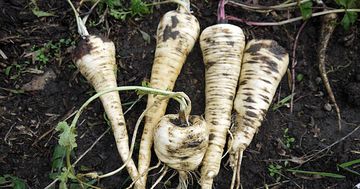Parsnips


Introduction
I think allotment growers hold parsnips in much higher regard than the general population. Indeed, I remember sowing my first parsnip seeds at the allotment and thinking whether it was worth the effort, crouching down in cold wet spring weather, fumbling to separate the seeds between my fingers.
A few years later I am totally converted. Our Sunday roast dinners simply would not be the same without our roast parsnips, and they also make delicious soups.
Planting
- Planting depth: 1 cm
- Planting spacing: thin to 15 cm between plants, 30 cm between a pair of rows (45 cm between pairs)
Harvesting
- Leave on the plot and dig up as needed (remember to mark the rows as the foliage dies back)
(inside)
(outside)
(fresh)
(stored)





 = freeze,
= freeze,  = store
= store
Varieties
There is often not a large choice of parsnip varieties to be found in shops. Some parsnips are longer than others, and there are small differences in whiteness.
For a home grower, the main choice is between long or short parsnip varieties. Long parsnips will perform well on loose sandy soils. If the soil is heavy, short and fat parsnips may be a better choice. Whatever type of parsnips are grown, they are deliciously sweet when cooked, whether roasted in the oven covered in oil, or adding their unique flavour to soups.
The easy way for a gardener to organise their growing and discover gardening ideas.
Growing
Parsnips are related to carrots – in Spanish the literal translation is ‘white carrots’. The big difference is that growing parsnips is much easier.
Parsnips can be affected by carrot fly and canker, but often to a much lesser extent than carrots. Both problems build up where parsnips are grown often, and is common on allotments. The best solution if crops are affected is to find a fresh location to grow them. There are also hybrid F1 varieties that have been bred to show resistance to these problems.
On my plot, which has loose sandy soil, I find it best to sow parsnip seeds direct into the soil in early spring, just when the weather starts to improve. If the weather is cold, for example regularly below 10 °C in the daytime, I wait longer. When warm spring air arrives, the soil should be moist for many weeks, giving sufficient encouragement to parsnip seeds to germinate. Attempting to germinate parsnip seed in hot dry conditions is notoriously unreliable.
After sowing, if there is no rain, I will regularly water the parsnip rows every few days to keep the soil moist.
The slow growing nature of parsnips means that the beds will need constant weeding. Luckily, the distinctive leaf shape of parsnips makes the seedlings easy to distinguish. Once the plants start to grow strongly, they can be thinned to the correct distance according to the variety chosen.
At this stage, watering is less of an issue, as parsnips send roots deep into the ground to find moisture. Parsnip rows will only require watering in very dry periods.
The sweetness of parsnips improves with the onset of cold weather, as a sharp ground frost will increase their sugar content. Parsnips are hardy vegetables and will keep for many months through winter in the soil where they grew, and dug up when required. If this is the intention, remember to clearly mark the location of the parsnips, as the above ground vegetation will die away.
